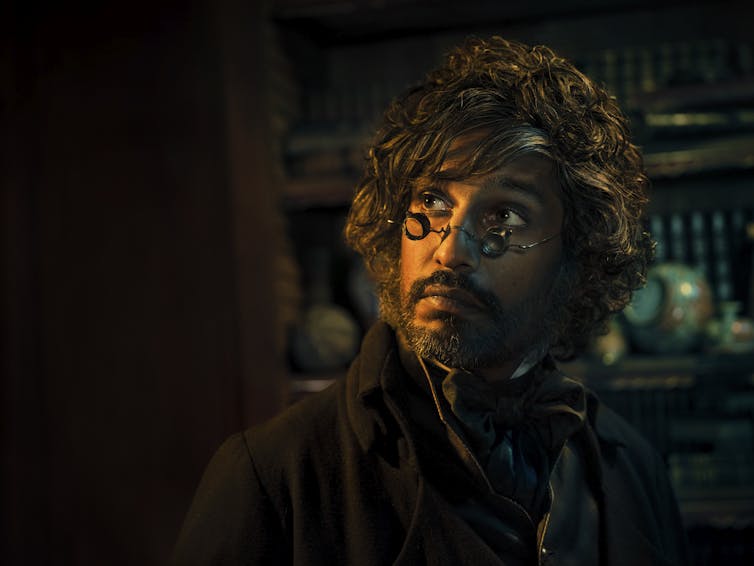A new BBC adaptation of Charles Dickens’ Great Expectations by British screenwriter Stephen Knight has hit screens across Britain, to immediate controversy from some viewers who criticised the colour-blind casting that involved non-white actors playing important characters.
The lawyer Jaggers is being played by black actor Ashley Thomas, the UK rapper better known by his stage name Bashy). The clerk John Wemmick is being played by Asian actor Rudi Dharmalingam. Most noticeably, Estella Havisham, who for many people is the book’s second significant figure, is being played by English-born Australian actor Shalom Brune-Franklin who is of Mauritian and Thai descent.
The series also addresses the brutal and corrupt history of the British empire. Abel Magwitch, the criminal who we learn is the benefactor of the story’s hero, Pip, asserts that the empire was “built on the lies of privileged white men”. This, alongside other changes, led to claims that the adaptation was both “woke” and unfaithful. “Woke” is a term derived from African-American vernacular which actually means alert to racial prejudice and discrimination, but is used by some, including racists, in the same way “political correctness gone mad” was in the 1990s and 2000s.
Such criticism is based on a reluctance to address empire and ignorance about the history of Britain.
The idea that there were no black people in Britain in Dickensian times is prevalent, but wrong. Even Booker Prize-winning black British author Bernardine Evaristo thought that Britain was a “white” country before the Windrush migrations beginning in 1948 until she read Peter Fryer’s Staying Power: The History of Black People in Britain, published in 1984. But 40 years later, the public misconception really should not persist.
A historically diverse Britain
Great Expectations was published in 1861, but the story of Pip and the people who encourage then disappoint his expectations takes place over 30 or so years, beginning around 1810. Bashy says his casting as Jaggers is realistic and, looking at this period, it is.
There were, at the very least, 5,000 black Georgians in London. There were many more black Victorians. While many were servants, a significant proportion were wealthy and independent members of British upper-class society.
Though unlikely to inherit titles, black Victorians could certainly be found among the likes of Estella, Wemmick and Jaggers. Several exhibitions, educational initiatives and publications from the past ten years attest to this.
Admittedly, colourblind casting does not come without its problems. There have been examples of white actors playing or voicing non-white characters and sometimes diversity quotas lead to negatively typecasting Black characters.
There are also suggestions that casting black actors without attention to cultural history is part of a process of assimilation, by ignoring African or Caribbean culture and heritage in favour of a so-called “neutral” (or white) culture, is even outright racism. But there is a distinction to be made between colourblind casting and “colour-conscious casting”, which involves adapting a script to reflect an actor’s skin colour or body shape or other physical characteristics.
For my point of view, colour-conscious casting has been adopted in this Great Expectations. There is, for instance, no reason Estella must be white since she is adopted.
Great Expectations begs to be retold.
Great Expectations begs to be retold. The story of a poor boy becoming a gentleman, only to find that his path to wealth and influence was built on the machinations of a criminal, leading him to reassess his value system, is irresistible.
There have been several exciting retellings, including Peter Carey’s Jack Maggs, which Stephen Knight’s 2023 adaptation surely draws upon, with its London abortionist Ma Britten and a thriving underworld industry built on child abduction and robbery. Lloyd Jones’s Mister Pip is another where Dickens’ novel is reinterpreted in Bougainville Island, Papua New Guinea.
Surely, readers want new stories?
There are many recent black British novels and short stories representing Georgian, Victorian and later pre-Windrush Black Britons. Their writers are putting black people back into British history.
For instance, David Dabydeen’s A Harlot’s Progress. Set in London in the 1730s, the novel imagines the life of the young Black page boy in an engraving by William Hogarth and tells his story as a favourite child slave among those on a slave ship. The child is brought to London as a gentleman’s servant, who is pestered to tell his story to an editor very like the editor who retold Mary Prince’s slave narrative for publication in Britain in 1831.

Bernardine Evaristo’s Yoruba Man Walking tells the story of a black sailor who settled in Cornwall, became a miner and was killed in the 1880s. Louise Hare’s recent Miss Aldridge Regrets is a murder mystery exploring race in Britain before the second world war.
The late Leonora Brito’s Dido Elizabeth Belle reconstructs the life of the 18th-century Black British heiress who lived in the family of Lord Chief Justice of England and Wales, and was a well-known figure in British upper-class society, inheriting wealth. Her sons were privately educated and became part of the British colonial administration.
Then there’s Caryl Phillips’s The Lost Child, which rewrites Wuthering Heights acknowledging to the original’s implication that Heathcliff is Black. In Bronte’s novel, he arrives speaking a strange language and is described as dark-skinned, and is a castaway on a ship from America, which has led many to surmise he may have been a descendent of African slaves or Indian indentured labourers.
And for those who don’t want new stories, Great Expectations remains in print.

